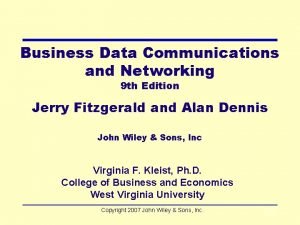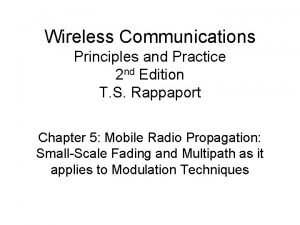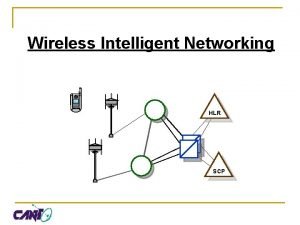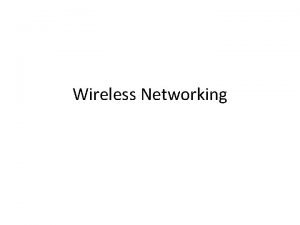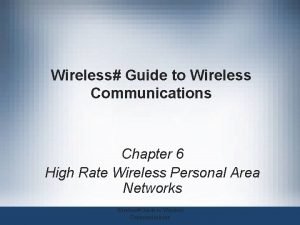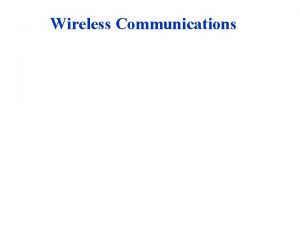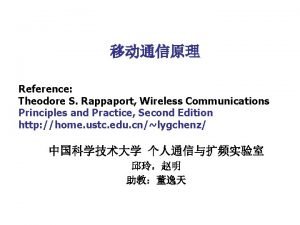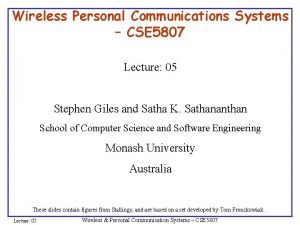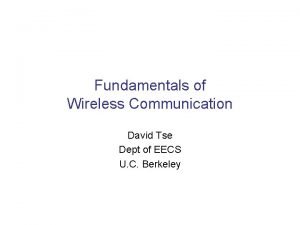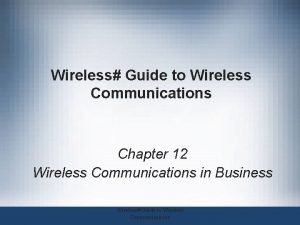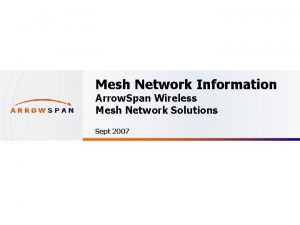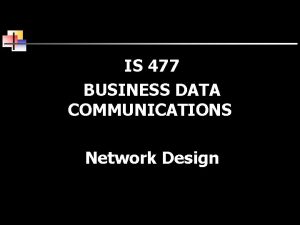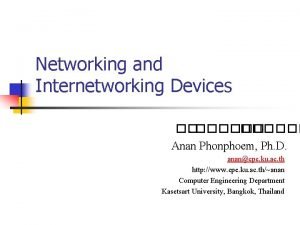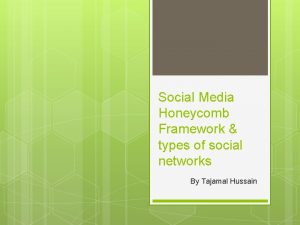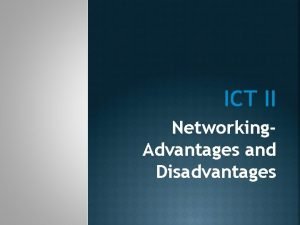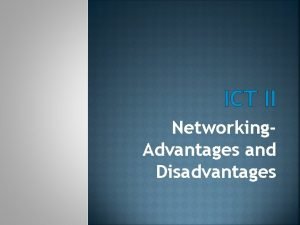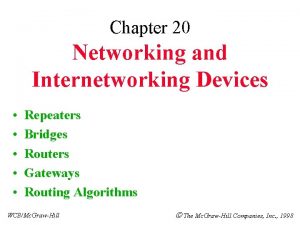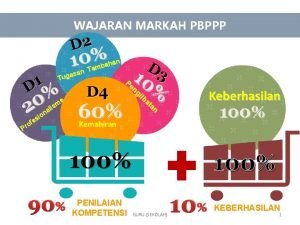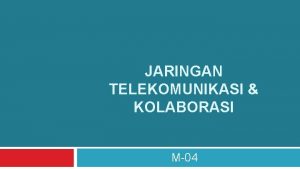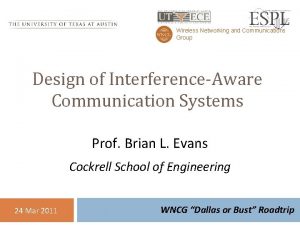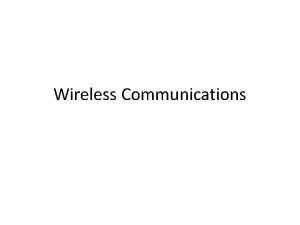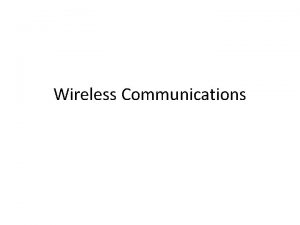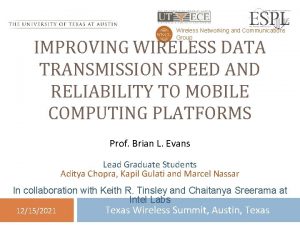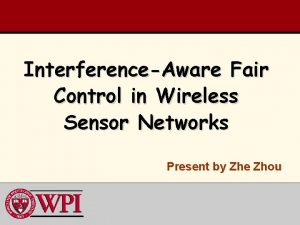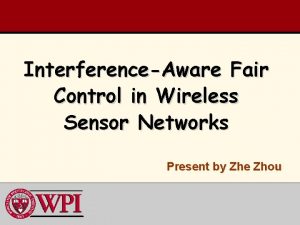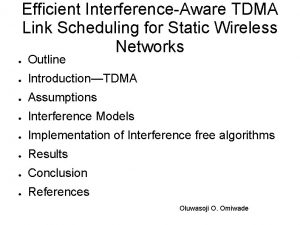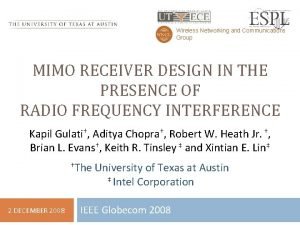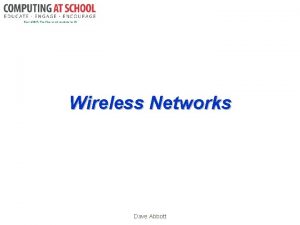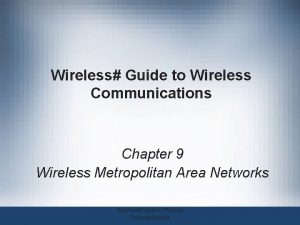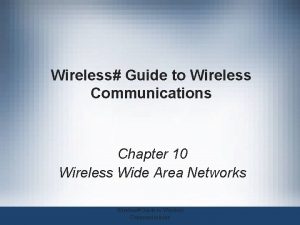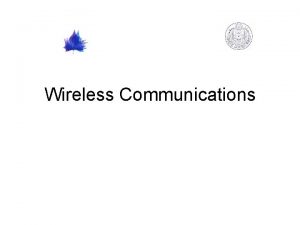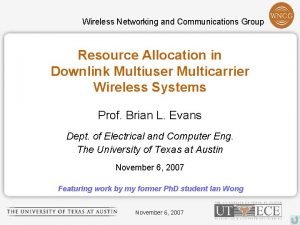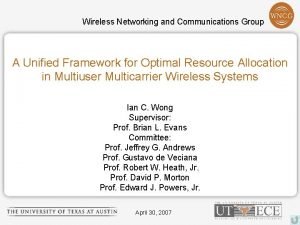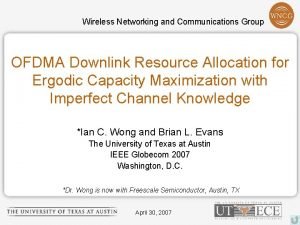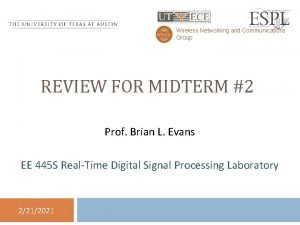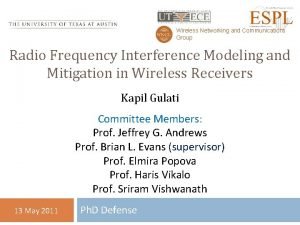Wireless Networking and Communications Group Design of InterferenceAware










![Noise in Powerline Communications 11 Superposition of five noise sources [Zimmermann, 2000] Different types Noise in Powerline Communications 11 Superposition of five noise sources [Zimmermann, 2000] Different types](https://slidetodoc.com/presentation_image_h2/fbb870a67fc03292e898e4599936b545/image-11.jpg)

























- Slides: 36

Wireless Networking and Communications Group Design of Interference-Aware Communication Systems Prof. Brian L. Evans Cockrell School of Engineering 24 Mar 2011 WNCG “Dallas or Bust” Roadtrip

Completed Projects – Prof. Evans 2 System SW release Prototype Companies equalization MATLAB DSP/C Freescale, TI MIMO testbed Lab. VIEW/PXI Oil & Gas Wimax/LTE resource allocation Lab. VIEW DSP/C Freescale, TI Camera image acquisition MATLAB DSP/C Intel, Ricoh Display image halftoning MATLAB C HP, Xerox video halftoning MATLAB fixed point conv. MATLAB ADSL CAD tools Contribution DSP Digital Signal Processor MIMO Multi-Input Multi-Output LTE PXI 17 Ph. D and 8 MS alumni Qualcomm FPGA Intel, NI Long-Term Evolution (cellular) PCI Extensions for Instrumentation

On-Going Projects – Prof. Evans 3 System Contributions SW release Prototype Companies Powerline Comm. noise reduction; testbed Lab. VIEW and C/C++ in PXI Freescale, IBM, SRC, TI Wimax/Wi. Fi RFI mitigation MATLAB Lab. VIEW/PXI Intel RF Test noise reduction Lab. VIEW/PXI NI Underwater Comm. MIMO testbed; space-time meth. MATLAB Lake Travis testbed Navy CAD Tools dist. computing. Linux/C++ Navy sonar Navy, NI DSP Digital Signal Processor MIMO Multi-Input Multi-Output PXI RFI 8 Ph. D and 4 MS students PCI Extensions for Instrumentation Radio Frequency Interference

Radio Frequency Interference (RFI) 4 (Wimax Basestation) (Microwave) (Wi-Fi) (Wimax) antenna (Wi-Fi) (Wimax Mobile) Wireless Communication Sources • Closely located sources • Coexisting protocols Non-Communication Sources Electromagnetic radiation baseband processor • • • Computational Platform Clock circuitry Power amplifiers Co-located transceivers Wireless Networking and Communications Group (Bluetooth)

RFI Modeling & Mitigation 5 Problem: RFI degrades communication performance Approach: Statistical modeling of RFI as impulsive noise Solution: Receiver design Listen to environment Build statistical model Use model to mitigate RFI Goal: Improve communication 10 -100 x reduction in bit error rate (done) 10 x improvement in network throughput (on-going) Project began January 2007 Wireless Networking and Communications Group

RFI Modeling 6 Ad hoc and cellular networks • Single antenna • Instantaneous statistics • Sensor networks • Ad hoc networks • Cellular networks • Dense Wi-Fi networks • Hotspots (e. g. café) Femtocell networks • Single antenna • Instantaneous statistics • In-cell and out-of-cell femtocell users Symmetric Alpha Stable Wireless Networking and Communications Group • Cluster of hotspots (e. g. marketplace) • Out-of-cell femtocell users Gaussian Mixture Model

RFI Mitigation 7 Interference + Thermal noise Pulse Shaping Pre-filtering Matched Filter Detection Rule Communication performance ~ 20 d. B 10 – 100 x reduction in bit error rate Single carrier, single antenna (SISO) Wireless Networking and Communications Group ~ 8 d. B Single carrier, two antenna (2 x 2 MIMO)

RFI Modeling & Mitigation Software 8 Freely distributable toolbox in MATLAB Simulation of RFI modeling/mitigation RFI generation Measured RFI fitting Filtering and detection methods Demos for RFI modeling and mitigation Example uses Snapshot of a demo System simulation (e. g. Wimax or powerline communications) Fit RFI measurements to statistical models Version 1. 6 beta Dec. 2010: http: //users. ece. utexas. edu/~bevans/projects/rfi/software Wireless Networking and Communications Group

Voltage Levels in Power Grid High-Voltage Source: Électricité Réseau Dist. France (ERDF) Medium-Voltage Low-Voltage Concentrator “Last mile” powerline communications on low/medium voltage line 9

Powerline Communications (PLC) 10 Concentrator controls medium to subscriber meters Plays role of basestation Applications Automatic meter reading (right) Smart energy management Device-specific billing (plug-in hybrid) Goal: Improve reliability & rate Mitigate impulsive noise Multichannel transmission Source: Powerline Intelligent Metering Evolution (PRIME) Alliance Draft v 1. 3 E
![Noise in Powerline Communications 11 Superposition of five noise sources Zimmermann 2000 Different types Noise in Powerline Communications 11 Superposition of five noise sources [Zimmermann, 2000] Different types](https://slidetodoc.com/presentation_image_h2/fbb870a67fc03292e898e4599936b545/image-11.jpg)
Noise in Powerline Communications 11 Superposition of five noise sources [Zimmermann, 2000] Different types of power spectral densities (PSDs) Colored Background Narrowband Noise: Can be lumped together as Asynchronous Periodic Impulsive Noise Synchronous to Main: Asynchronous Noise: Periodic Impulsive Noise to Impulsive Main: • PSD decreases • with Sinusoidal frequency with modulated amplitudes • Background 50 -100 Hz, Short. Noise duration • impulses Caused by switching transients • 50 -200 k. Hz Generalized • Superposition • of numerous Affects several noise sources • subbands PSD decreases with frequency • Arbitrary interarrivals with micro-millisecond • • Caused by switching power supplies with lower intensity • Caused by medium andnarrowbands shortwave • Caused by power convertors durations • Approximated by Time varying (order broadcast of minutes channels and hours) • 50 d. B above background noise Broadband Powerline Communications: Network Design

Powerline Noise Modeling & Mitigation 12 Problem: Impulsive noise is primary impairment in powerline communications Approach: Statistical modeling Solution: Receiver design Listen to environment Build statistical model Use model to mitigate RFI Goal: Improve communication 10 -100 x reduction in bit error rate 10 x improvement in network throughput Wireless Networking and Communications Group

Preliminary Noise Measurement 13

Preliminary Noise Measurement Colored Background Noise 14

Preliminary Noise Measurement Narrowband Noise Colored Background Noise 15

Preliminary Noise Measurement Periodic and Asynchronous Noise Narrowband Noise Colored Background Noise 16

Powerline Communications Testbed 17 Integrate ideas from multiple standards (e. g. PRIME) Quantify communication performance vs complexity tradeoffs Extend our existing real-time DSL testbed (deployed in field) GUI Adaptive signal processing methods Channel modeling, impulsive noise filters & equalizers Medium access control layer scheduling Effective and adaptive resource allocation

Thank you for your attention! 18

Backup

Designing Interference-Aware Receivers 20 Guard zone Statistical Modeling of RFI TS • R Derive analytically S CT • Estimate parameters at receiver Physical (PHY) Layer • Receiver pre-filtering • Receiver detection • Forward error correction Medium Access Control (MAC) Layer • Interference sense and avoid • Optimize MAC parameters (e. g. guard zone size, transmit power) RTS / CTS: Request / Clear to send Example: Dense Wi. Fi Networks Wireless Networking and Communications Group

Statistical Models (isotropic, zero centered) 21 Symmetric Alpha Stable [Furutsu Characteristic function Gaussian Mixture Model [Sorenson & Alspach, 1971] & Ishida, 1961] [Sousa, 1992] Amplitude distribution Middleton Class A (w/o Gaussian component) [Middleton, 1977] Wireless Networking and Communications Group

Validating Statistical RFI Modeling 22 Validated for measurements of radiated RFI from laptop Radiated platform RFI • 25 RFI data sets from Intel • 50, 000 samples at 100 MSPS • Laptop activity unknown to us Smaller KL divergence • Closer match in distribution • Does not imply close match in tail probabilities Wireless Networking and Communications Group

Turbo Codes in Presence of RFI 23 Return Parity 1 Systematic Data Parity 2 - Decoder 1 Gaussian channel: - Middleton Class A channel: - Decoder 2 - Extrinsic Information Leads to a 10 d. B improvement at BER of 10 -5 [Umehara 03] Independent of channel statistics Wireless Networking and Communications Group A-priori Information Depends on channel statistics Independent of channel statistics

RFI Mitigation Using Error Correction 24 Turbo decoder Return - Parity 1 Decoder 1 Systematic Data - Interleaver - Parity 2 Decoder 2 - Interleaver Decoding depends on the RFI statistics 10 d. B improvement at BER 10 -5 can be achieved using accurate RFI statistics [Umehara, 2003] Wireless Networking and Communications Group

Extensions to Statistical RFI Modeling 25 Extended to include spatial and temporal dependence Statistical Modeling of RFI Single Antenna Instantaneous statistics • Symbol errors Spatial Dependence • Multi-antenna receivers Multivariate extensions of Symmetric Alpha Stable Gaussian mixture model Wireless Networking and Communications Group Temporal Dependence • Burst errors • Coded transmissions • Delays in network

RFI Modeling: Joint Interference Statistics 26 Ad hoc networks Cellular networks Multivariate Symmetric Alpha Stable Multivariate Gaussian Mixture Model Throughput performance of ad hoc networks ~1. 6 x Wireless Networking and Communications Group Network throughput improved by optimizing distribution of ON Time of users (MAC parameter)

RFI Mitigation: Multi-carrier systems 27 Proposed Receiver Iterative Expectation Maximization (EM) based on noise model Communication Performance Simulation Parameters • BPSK Modulation • Interference Model 2 -term Gaussian Mixture Model ~ 5 d. B Wireless Networking and Communications Group

Smart Grids: The Big Picture 28 Real-Time : Customers profiling enabling good predictions in demand = no need to use an additional power plant Long distance communication : access to isolated houses Micro- production : better knowledge of energy produced to balance the network Demand-side management : boilers are activatedduring the night whenelectricityisavaila ble Anydisturbance due to a storm : action canbetakeninmediatelybas ed on real-time information Smart building : significant cost reduction on energy bill through remote monitoring Smart car : charge of electricalvehicleswhile panels are producing Source: ETSI Security features. Fireisdetect ed : relaycanbeswitched off rapidly

Systems of systems Networks of networks Networks of systems Systems ion Circuit design Data acq. Waveforms Antennas Wires Devices nic Communication links mu Processors tat pu m Co Collaboration with UT faculty outside of WNCG Protocols Operating systems ati Middleware Compilers on Networks Co m 29 Wireless Networking & Comm. Group Applications 17 faculty 140 grad students

Wireless Networking & Comm. Group 30 Computation Communications Networking Applications B. Evans Embedded DSP J. Andrews Communication S. Nettles Network Design B. Bard Security C. Caramanis Optimization A. Bovik Image/Video A. Gerstlauer Embedded Sys R. Heath Comm/DSP S. Shakkottai Network Theory G. de Veciana Networking S. Sanghavi Network Science A. Tewfik Biomedical S. Vishwanath Sensor Networks L. Qiu Network Design T. Rappaport RF IC Design T. Humphreys GPS/Navigation H. Vikalo Genomic DSP

Our Publications 31 Journal Publications • K. Gulati, B. L. Evans, J. G. Andrews, and K. R. Tinsley, “Statistics of Co-Channel Interference in a Field of Poisson and Poisson-Poisson Clustered Interferers”, IEEE Transactions on Signal Processing, vol. 58, no. 12, Dec. 2010, pp. 6207 -6222. • M. Nassar, K. Gulati, M. R. De. Young, B. L. Evans and K. R. Tinsley, “Mitigating Near. Field Interference in Laptop Embedded Wireless Transceivers”, Journal of Signal Processing Systems, Mar. 2009, invited paper. Conference Publications • M. Nassar, X. E. Lin, and B. L. Evans, “Stochastic Modeling of Microwave Oven Interference in WLANs”, Proc. IEEE Int. Conf. on Comm. , Jun. 5 -9, 2011. • K. Gulati, B. L. Evans, and K. R. Tinsley, “Statistical Modeling of Co-Channel Interference in a Field of Poisson Distributed Interferers”, Proc. IEEE Int. Conf. on Acoustics, Speech, and Signal Proc. , Mar. 14 -19, 2010. • K. Gulati, A. Chopra, B. L. Evans, and K. R. Tinsley, “Statistical Modeling of Co-Channel Interference”, Proc. IEEE Int. Global Comm. Conf. , Nov. 30 -Dec. 4, 2009. Cont… Wireless Networking and Communications Group

Our Publications 32 Conference Publications (cont…) • A. Chopra, K. Gulati, B. L. Evans, K. R. Tinsley, and C. Sreerama, “Performance Bounds of MIMO Receivers in the Presence of Radio Frequency Interference”, Proc. IEEE Int. Conf. on Acoustics, Speech, and Signal Proc. , Apr. 19 -24, 2009. • K. Gulati, A. Chopra, R. W. Heath, Jr. , B. L. Evans, K. R. Tinsley, and X. E. Lin, “MIMO Receiver Design in the Presence of Radio Frequency Interference”, Proc. IEEE Int. Global Communications Conf. , Nov. 30 -Dec. 4 th, 2008. • M. Nassar, K. Gulati, A. K. Sujeeth, N. Aghasadeghi, B. L. Evans and K. R. Tinsley, “Mitigating Near-Field Interference in Laptop Embedded Wireless Transceivers”, Proc. IEEE Int. Conf. on Acoustics, Speech, and Signal Proc. , Mar. 30 -Apr. 4, 2008. Software Releases • K. Gulati, M. Nassar, A. Chopra, B. Okafor, M. R. De. Young, N. Aghasadeghi, A. Sujeeth, and B. L. Evans, "Radio Frequency Interference Modeling and Mitigation Toolbox in MATLAB", version 1. 6 beta, Dec. 16, 2010. Wireless Networking and Communications Group

References 33 RFI Modeling 1. D. Middleton, “Non-Gaussian noise models in signal processing for telecommunications: New methods and results for Class A and Class B noise models”, IEEE Trans. Info. Theory, vol. 45, no. 4, pp. 1129 -1149, May 1999. 2. K. Furutsu and T. Ishida, “On theory of amplitude distributions of impulsive random noise, ” J. Appl. Phys. , vol. 32, no. 7, pp. 1206– 1221, 1961. 3. J. Ilow and D. Hatzinakos, “Analytic alpha-stable noise modeling in a Poisson field of interferers or scatterers”, IEEE transactions on signal processing, vol. 46, no. 6, pp. 1601 -1611, 1998. 4. E. S. Sousa, “Performance of a spread spectrum packet radio network link in a Poisson field of interferers, ” IEEE Transactions on Information Theory, vol. 38, no. 6, pp. 1743– 1754, Nov. 1992. 5. X. Yang and A. Petropulu, “Co-channel interference modeling and analysis in a Poisson field of interferers in wireless communications, ” IEEE Transactions on Signal Processing, vol. 51, no. 1, pp. 64– 76, Jan. 2003. 6. E. Salbaroli and A. Zanella, “Interference analysis in a Poisson field of nodes of finite area, ” IEEE Transactions on Vehicular Technology, vol. 58, no. 4, pp. 1776– 1783, May 2009. 7. M. Z. Win, P. C. Pinto, and L. A. Shepp, “A mathematical theory of network interference and its applications, ” Proceedings of the IEEE, vol. 97, no. 2, pp. 205– 230, Feb. 2009. Wireless Networking and Communications Group

References 34 Parameter Estimation 1. S. M. Zabin and H. V. Poor, “Efficient estimation of Class A noise parameters via the EM [Expectation-Maximization] algorithms”, IEEE Trans. Info. Theory, vol. 37, no. 1, pp. 60 -72, Jan. 1991. 2. G. A. Tsihrintzis and C. L. Nikias, "Fast estimation of the parameters of alpha-stable impulsive interference", IEEE Trans. Signal Proc. , vol. 44, Issue 6, pp. 1492 -1503, Jun. 1996. Communication Performance of Wireless Networks 1. R. Ganti and M. Haenggi, “Interference and outage in clustered wireless ad hoc networks, ” IEEE Transactions on Information Theory, vol. 55, no. 9, pp. 4067– 4086, Sep. 2009. 2. A. Hasan and J. G. Andrews, “The guard zone in wireless ad hoc networks, ” IEEE Transactions on Wireless Communications, vol. 4, no. 3, pp. 897– 906, Mar. 2007. 3. X. Yang and G. de Veciana, “Inducing multiscale spatial clustering using multistage MAC contention in spread spectrum ad hoc networks, ” IEEE/ACM Transactions on Networking, vol. 15, no. 6, pp. 1387– 1400, Dec. 2007. 4. S. Weber, X. Yang, J. G. Andrews, and G. de Veciana, “Transmission capacity of wireless ad hoc networks with outage constraints, ” IEEE Transactions on Information Theory, vol. 51, no. 12, pp. 4091 -4102, Dec. 2005. Wireless Networking and Communications Group

References 35 Communication Performance of Wireless Networks (cont…) 5. S. Weber, J. G. Andrews, and N. Jindal, “Inducing multiscale spatial clustering using multistage MAC contention in spread spectrum ad hoc networks, ” IEEE Transactions on Information Theory, vol. 53, no. 11, pp. 4127 -4149, Nov. 2007. 6. J. G. Andrews, S. Weber, M. Kountouris, and M. Haenggi, “Random access transport capacity, ” IEEE Transactions On Wireless Communications, Jan. 2010, submitted. [Online]. Available: http: //arxiv. org/abs/0909. 5119 7. M. Haenggi, “Local delay in static and highly mobile Poisson networks with ALOHA, " in Proc. IEEE International Conference on Communications, Cape Town, South Africa, May 2010. 8. F. Baccelli and B. Blaszczyszyn, “A New Phase Transitions for Local Delays in MANETs, ” in Proc. of IEEE INFOCOM, San Diego, CA, 2010, to appear. Receiver Design to Mitigate RFI 1. A. Spaulding and D. Middleton, “Optimum Reception in an Impulsive Interference Environment. Part I: Coherent Detection”, IEEE Trans. Comm. , vol. 25, no. 9, Sep. 1977 2. J. G. Gonzalez and G. R. Arce, “Optimality of the Myriad Filter in Practical Impulsive-Noise Environments”, IEEE Trans. on Signal Processing, vol 49, no. 2, Feb 2001 Wireless Networking and Communications Group

References 36 Receiver Design to Mitigate RFI (cont…) 3. S. Ambike, J. Ilow, and D. Hatzinakos, “Detection for binary transmission in a mixture of Gaussian noise and impulsive noise modelled as an alpha-stable process, ” IEEE Signal Processing Letters, vol. 1, pp. 55– 57, Mar. 1994. 4. G. R. Arce, Nonlinear Signal Processing: A Statistical Approach, John Wiley & Sons, 2005. 5. Y. Eldar and A. Yeredor, “Finite-memory denoising in impulsive noise using Gaussian mixture models, ” IEEE Transactions on Circuits and Systems II: Analog and Digital Signal Processing, vol. 48, no. 11, pp. 1069 -1077, Nov. 2001. 6. J. H. Kotecha and P. M. Djuric, “Gaussian sum particle ltering, ” IEEE Transactions on Signal Processing, vol. 51, no. 10, pp. 2602 -2612, Oct. 2003. 7. J. Haring and A. J. Han Vick, “Iterative Decoding of Codes Over Complex Numbers for Impulsive Noise Channels”, IEEE Trans. On Info. Theory, vol 49, no. 5, May 2003. 8. Ping Gao and C. Tepedelenlioglu. “Space-time coding over mimo channels with impulsive noise”, IEEE Trans. on Wireless Comm. , 6(1): 220– 229, January 2007. RFI Measurements and Impact 1. J. Shi, A. Bettner, G. Chinn, K. Slattery and X. Dong, "A study of platform EMI from LCD panels – impact on wireless, root causes and mitigation methods, “ IEEE International Symposium on Electromagnetic Compatibility, vol. 3, no. , pp. 626 -631, 14 -18 Aug. 2006 Wireless Networking and Communications Group
 Business data communications and networking
Business data communications and networking Business data communication and networking
Business data communication and networking Introduction to data communications and networking
Introduction to data communications and networking Business data communications and networking
Business data communications and networking Sdn vs traditional network
Sdn vs traditional network Telecommunications the internet and wireless technology
Telecommunications the internet and wireless technology Geomerty
Geomerty Any time interrogation call flow
Any time interrogation call flow Wireless network definition
Wireless network definition Guide to wireless communications 4th edition
Guide to wireless communications 4th edition Andrea goldsmith wireless communications
Andrea goldsmith wireless communications Subsea wireless communications
Subsea wireless communications Theodore s rappaport wireless communications
Theodore s rappaport wireless communications Cse
Cse Fundamentals of wireless communication solution
Fundamentals of wireless communication solution Guide to wireless communications
Guide to wireless communications Crisis communication working group
Crisis communication working group Tactical communication examples
Tactical communication examples Communications solutions group
Communications solutions group Outdoor wireless mesh network design
Outdoor wireless mesh network design Communications network design
Communications network design Benefits of transferring data over a wired network
Benefits of transferring data over a wired network Anova within group and between group
Anova within group and between group Characteristics of social groups
Characteristics of social groups Amino group and carboxyl group
Amino group and carboxyl group Amino group and carboxyl group
Amino group and carboxyl group Group 1 and group 2 specialties
Group 1 and group 2 specialties Joining together group theory and group skills
Joining together group theory and group skills Networking and internetworking devices
Networking and internetworking devices Honeycomb social network
Honeycomb social network Persuation and networking
Persuation and networking Site:slidetodoc.com
Site:slidetodoc.com Essay advantages and disadvantages
Essay advantages and disadvantages Computer networks assignment
Computer networks assignment Networking and internetworking devices
Networking and internetworking devices Jalinan dan jaringan (networking and linkages)
Jalinan dan jaringan (networking and linkages) Networking and collaboration
Networking and collaboration



